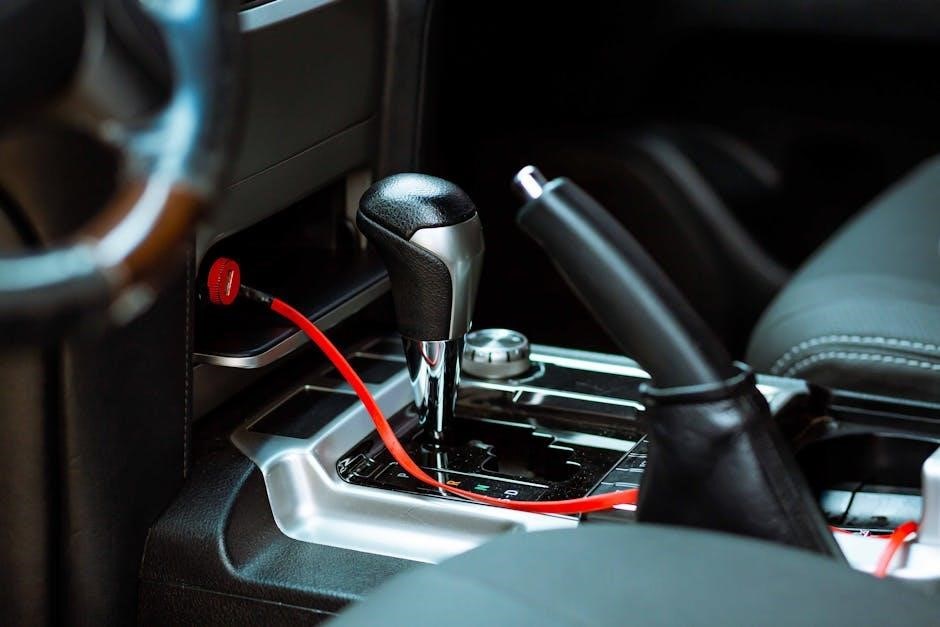new hampshire driver’s manual
The New Hampshire Drivers Manual is the official guide for Granite State motorists, offering comprehensive information on road rules, traffic laws, and safe driving practices. Available as a free PDF download and audiobook, it ensures accessibility for all. Regular updates keep the manual current with state laws, making it an essential resource for both new and experienced drivers to ensure safe and responsible driving.
Overview of the Manual
The New Hampshire Drivers Manual serves as a detailed guide for understanding road rules, traffic laws, and safe driving practices in the state. It is designed to help both new and experienced drivers navigate the complexities of driving responsibly. The manual covers essential topics such as speed limits, right-of-way rules, seat belt laws, and driving under the influence regulations. Additionally, it provides information on traffic signs, defensive driving techniques, and emergency procedures. Available in PDF and audiobook formats, the manual is regularly updated to reflect current state laws and regulations. Its comprehensive structure ensures that drivers are well-prepared for exams and equipped with the knowledge needed to stay safe on the road.
Importance of the Manual for Drivers
The New Hampshire Drivers Manual is a vital resource for all motorists, providing essential information to ensure safe and lawful driving. It serves as a foundational guide for new drivers, helping them understand road rules, traffic laws, and safe practices. For experienced drivers, it offers a refresher on state-specific regulations and updates on any changes in driving laws. The manual is also crucial for exam preparation, as it covers key topics tested on driver’s license exams. By studying the manual, drivers can reduce the risk of accidents, avoid legal penalties, and contribute to a safer driving environment for everyone on New Hampshire roads.
Availability and Formats (PDF, Audiobook)
The New Hampshire Drivers Manual is readily available in multiple formats to accommodate different learning preferences. Drivers can download the manual as a free PDF from the NH DMV website, making it easily accessible for study at home or on the go. Additionally, an audiobook version is provided, allowing drivers to listen and learn while commuting or multitasking. Both formats ensure that the manual is accessible to everyone, including those with visual impairments or preferences for auditory learning. Regular updates are made to both versions to reflect the latest state laws and regulations, ensuring drivers receive accurate and up-to-date information.
Road Rules and Traffic Laws in New Hampshire
The New Hampshire Drivers Manual is a key guide for understanding road rules, traffic laws, and safe practices. It’s available as a free PDF and audiobook, ensuring accessibility for all drivers. Regular updates keep it current with state laws, making it essential for both new and experienced drivers to ensure safe and lawful driving.
Speed Limits and Restrictions
The New Hampshire Drivers Manual outlines specific speed limits and restrictions to ensure safe driving. Urban areas typically have a 30-35 mph limit, while rural highways range from 45-65 mph. School zones and construction areas have reduced speeds, often 20-45 mph. The manual emphasizes the importance of adhering to posted limits, as exceeding them can result in fines or penalties. Additionally, certain vehicles, like trucks or buses, may have lower speed restrictions. The NH DMV regularly updates these guidelines to reflect road conditions and safety standards, ensuring drivers are informed and compliant with state laws to maintain road safety for all users.
Right-of-Way Rules

The New Hampshire Drivers Manual details right-of-way rules to promote safe and orderly traffic flow. Drivers must yield to pedestrians, emergency vehicles, and other motorists as specified. At intersections, the vehicle on the right has the right-of-way unless turning left with a green arrow. When approaching a four-way stop, the first vehicle to stop goes first. Roundabouts require yielding to traffic already in the circle. Failure to follow right-of-way rules can result in accidents or penalties. The manual emphasizes understanding these rules to ensure courteous and safe driving practices for all road users, reducing conflicts and enhancing overall traffic safety.
Seat Belt and Child Safety Laws
The New Hampshire Drivers Manual emphasizes the importance of seat belt and child safety laws to protect all vehicle occupants. All drivers and passengers must wear a seat belt, and children under 18 must use a properly secured child restraint system. Infants under 7 years old and weighing less than 40 pounds require a rear-facing or forward-facing car seat. Children aged 7 or older or weighing over 40 pounds must use a booster seat until they can safely wear a seat belt. Violations of these laws result in fines and penalties. The manual stresses that adhering to these regulations is crucial for preventing injuries and fatalities, ensuring safer roadways for everyone.
Driving Under the Influence (DUI) Laws
The New Hampshire Drivers Manual outlines strict DUI laws to combat impaired driving. Drivers with a blood alcohol content (BAC) of 0.08% or higher face legal consequences. For commercial drivers, the BAC limit is 0.04%, and underage drivers (under 21) are subject to a zero-tolerance policy. Penalties include fines, license suspension, and mandatory ignition interlock devices. Repeat offenses escalate penalties, including longer suspensions and potential jail time. The manual emphasizes the dangers of driving under the influence of alcohol or drugs, urging drivers to make responsible choices to protect themselves and others on the road. These laws aim to reduce accidents and ensure public safety.

Traffic Signs and Signals
Traffic signs and signals in New Hampshire guide drivers, ensuring safe navigation. The manual details types of signs, such as regulatory, warning, and informational, and explains traffic signal lights to promote adherence to road rules and enhance safety for all road users.
Types of Traffic Signs

The New Hampshire Drivers Manual categorizes traffic signs into three main types: regulatory, warning, and informational. Regulatory signs, such as Stop, Yield, and Speed Limit signs, enforce traffic laws and driver actions. Warning signs, like Curve Ahead or Pedestrian Crossing, alert drivers to potential hazards. Informational signs provide guidance, such as directional signs or Service Area indicators. Understanding these sign types is crucial for safe navigation and compliance with state traffic laws. The manual details each category, ensuring drivers recognize and respond appropriately to signage, promoting safe and efficient travel on New Hampshire roads.
Understanding Traffic Signal Lights
Traffic signal lights in New Hampshire are standardized to ensure clear communication to drivers. Red signals indicate when drivers must stop, while green signals allow vehicles to proceed. Yellow lights serve as a warning that the signal is about to change. Special signals, such as arrows, indicate specific lanes or turning directions. Pedestrian signals and countdown timers are also used to manage traffic flow. The manual emphasizes the importance of adhering to these signals to maintain safety and order on the road. Understanding and obeying traffic lights is crucial for compliance with state traffic laws and for preventing accidents.
Special Signs for Pedestrians and Cyclists
The New Hampshire Drivers Manual highlights specific traffic signs designed to protect pedestrians and cyclists. These include pedestrian crossing signs, bike lane markings, and shared-use path symbols. The manual emphasizes the importance of recognizing these signs to ensure the safety of vulnerable road users. Drivers are reminded to yield to pedestrians at crosswalks and to share the road with cyclists, maintaining a safe distance. Special signs also indicate areas where pedestrians and cyclists have priority, such as school zones or designated bike routes. Understanding these signs is crucial for promoting harmony and safety among all road users in New Hampshire.
Safe Driving Practices
The New Hampshire Drivers Manual covers essential safe driving practices, emphasizing defensive techniques, maintaining safe distances, and staying alert to prevent accidents and ensure road safety.
General Safe Driving Tips
The New Hampshire Drivers Manual emphasizes general safe driving tips to promote responsible and cautious behavior on the road. These include maintaining a safe following distance, using turn signals consistently, and avoiding distractions like texting or eating while driving. Drivers are encouraged to stay alert, adjust speeds according to road conditions, and be mindful of pedestrians and cyclists. The manual also highlights the importance of wearing seat belts and ensuring all passengers are properly restrained. By following these tips, drivers can significantly reduce the risk of accidents and contribute to a safer driving environment for everyone on New Hampshire’s roads.
Defensive Driving Techniques
The New Hampshire Drivers Manual highlights defensive driving techniques as a critical component of safe driving. These techniques emphasize anticipation, awareness, and proactive behavior to minimize risks on the road. Drivers are encouraged to stay alert, maintain a safe following distance, and be prepared for unexpected actions by other motorists. Scanning the road ahead, using mirrors, and anticipating potential hazards are key strategies. The manual also advises drivers to adjust their speed according to road conditions and to avoid aggressive behaviors such as tailgating or weaving in and out of lanes. By adopting these defensive practices, drivers can significantly reduce the likelihood of accidents and enhance overall road safety.

Emergency Procedures and Accident Response
The New Hampshire Drivers Manual provides detailed guidance on emergency procedures and accident response to ensure driver safety. In the event of an accident, drivers should remain calm, secure the scene, and assess injuries. The manual emphasizes the importance of notifying authorities immediately and exchanging information with all parties involved. It also outlines steps for safely exiting a vehicle and providing assistance if possible. Additionally, the manual covers procedures for breakdowns, such as moving to a safe location and using hazard lights. Understanding these protocols helps drivers respond effectively in emergencies, reducing risks and preventing further incidents. Preparation is key to handling such situations responsibly.

Licensing Process in New Hampshire
The New Hampshire Drivers Manual guides applicants through the licensing process, detailing steps to obtain, renew, or upgrade licenses. It covers requirements for standard, motorcycle, and CDL licenses, ensuring compliance with state regulations and providing resources for a smooth application experience.
Steps to Obtain a Driver’s License
To obtain a driver’s license in New Hampshire, applicants must follow a structured process outlined in the NH Drivers Manual. First, study the manual to understand road rules and safety practices. Next, pass a vision test and a written knowledge test. For underage applicants, completing a driver’s education course is required. After passing these initial tests, applicants must log a minimum number of supervised driving hours. Once these steps are completed, they can take the road test to demonstrate driving skills. Finally, applicants submit the required documents and fees to receive their license. This process ensures new drivers are well-prepared and knowledgeable.
Renewing a Driver’s License
Renewing a driver’s license in New Hampshire is a straightforward process outlined in the NH Drivers Manual. Licenses typically expire every five years, and renewal can be done online, in person, or by mail. Applicants must provide required documents, such as proof of identity and residency, and pay the renewal fee. A vision test may be required for in-person renewals. The manual emphasizes the importance of keeping licenses up to date to avoid penalties. Renewal ensures compliance with state laws and maintains driving privileges. The process is designed to be efficient, with online options offering added convenience for residents.
Special Licenses (Motorcycle, CDL)
New Hampshire offers specialized licenses for motorcycle and commercial vehicle operation. A motorcycle license requires completing a rider course or passing a vision and written test. For a Commercial Driver’s License (CDL), applicants must meet federal and state requirements, including age restrictions, medical exams, and knowledge tests. The NH Drivers Manual provides detailed guidance on eligibility, application processes, and required documentation. Additional endorsements, such as hazardous materials or passenger transport, may require further testing. The manual ensures applicants understand the unique responsibilities and regulations for operating these vehicles safely and legally. Regular updates keep the information current with state and federal standards.
Manual Availability and Updates
The New Hampshire Drivers Manual is available as a free PDF download and audiobook, ensuring accessibility for all. Regular updates keep the manual current with state laws and regulations, providing the most accurate and essential information for drivers. The latest versions can be accessed directly through the NH DMV website, ensuring everyone stays informed and compliant with driving requirements.
Downloading the PDF Version
The New Hampshire Drivers Manual is readily available as a free PDF download from the NH DMV website. This digital format allows drivers to access the manual anytime, anywhere, making it convenient for study and reference. The PDF version is regularly updated to reflect the latest state laws and regulations, ensuring drivers receive accurate and current information. It covers essential topics such as road rules, traffic signs, and safe driving practices, making it an invaluable resource for both new and experienced drivers. The manual is also accessible in audiobook format for those who prefer listening. Downloading the PDF ensures you have a comprehensive guide to prepare for exams and stay informed about driving requirements in New Hampshire.
Accessing the Audiobook Version
The New Hampshire Drivers Manual is also available as a free audiobook, providing an accessible format for drivers who prefer listening or have visual impairments. This version can be accessed online through the NH DMV website, allowing users to listen while commuting or studying. The audiobook covers the same essential topics as the PDF, including road rules, traffic signs, and safe driving practices. It is regularly updated to align with the latest state laws and regulations. This format ensures that all drivers, regardless of their preferences or needs, can easily access and benefit from the manual’s comprehensive guidance.
Regular Updates and Revisions
The New Hampshire Drivers Manual undergoes regular updates to ensure it aligns with the latest state laws and regulations. These revisions are crucial for maintaining accuracy and relevance, as traffic laws and road rules can change over time. The NH DMV is committed to keeping the manual current, reflecting new legislation, safety guidelines, and driving best practices. Updates are applied to both the PDF and audiobook versions simultaneously, ensuring consistency across all formats. This commitment to regular revisions makes the manual a reliable and up-to-date resource for drivers, helping them stay informed and compliant with New Hampshire’s driving requirements.

Preparing for Driving Exams
The New Hampshire Drivers Manual is a key guide for exam preparation, offering practice tests, study materials, and focusing on essential topics to ensure success in driving exams.
Practice Tests and Study Materials
The New Hampshire Drivers Manual offers a variety of practice tests and study materials to help individuals prepare for their driving exams. These resources include practice permit tests, marathon tests, and flashcards, all designed to familiarize users with the content of the manual. The manual itself is available in PDF and audiobook formats, making it accessible to everyone. By utilizing these study materials, drivers can master road rules, traffic signs, and safe driving practices. Regular updates ensure the information is current and aligned with state laws. These tools are essential for building confidence and ensuring success in both written and practical driving exams.
Key Topics to Focus On
The New Hampshire Drivers Manual emphasizes several key topics to ensure safe and responsible driving. These include understanding traffic laws, recognizing road signs, and mastering safe driving practices. The manual also covers licensing steps, vehicle registration, and insurance requirements. Additionally, it highlights defensive driving techniques and emergency procedures. Special attention is given to seat belt and child safety laws, as well as DUI regulations. By focusing on these areas, drivers can gain a comprehensive understanding of state-specific rules and best practices. This knowledge is crucial for both new and experienced drivers to navigate New Hampshire roads confidently and safely.
Importance of the Manual in Exam Prep
The New Hampshire Drivers Manual is a vital resource for exam preparation, offering detailed information on road rules, traffic signs, and safe driving practices. As the official guide, it aligns perfectly with test questions, ensuring candidates understand state-specific laws and regulations. The manual is available in PDF and audiobook formats, making it accessible for all learners. Regular updates ensure the content reflects the latest changes in driving laws. By studying the manual, applicants can familiarize themselves with key topics, such as speed limits, right-of-way rules, and license requirements. Practice tests and study materials complement the manual, reinforcing knowledge and boosting confidence for a successful exam.

New Hampshire-Specific Driving Regulations
New Hampshire has unique driving laws, including vehicle registration requirements, mandatory insurance, and local ordinances. These regulations ensure compliance with state-specific rules for safe road operations.

Vehicle Registration Requirements
Vehicle registration in New Hampshire requires proof of ownership, insurance, and identity. Owners must submit an application, pay fees, and provide a vehicle title or previous registration. Renewals are periodic, typically annual, and failure to comply results in penalties. The NH DMV manual outlines specific documentation and steps for registering vehicles, ensuring compliance with state laws. This process helps maintain accurate records and supports road safety initiatives. Proper registration is mandatory for legal operation of vehicles in the state.
Insurance Requirements
In New Hampshire, drivers must meet specific insurance requirements to legally operate a vehicle. The state mandates liability insurance to cover damages or injuries caused to others. Minimum coverage includes $25,000 for bodily injury per person, $50,000 per accident, and $25,000 for property damage. Uninsured/underinsured motorist coverage is also required to protect against accidents involving drivers without adequate insurance. The NH drivers manual details these requirements, emphasizing the importance of maintaining valid insurance to avoid penalties, such as fines or license suspension. Proper insurance ensures financial responsibility and helps safeguard all road users in the event of an accident.
Local Driving Laws and Ordinances
New Hampshire drivers must adhere to local driving laws and ordinances, which may vary by municipality. These regulations are detailed in the NH drivers manual and include rules for parking, traffic signs, and specific community guidelines. For example, some towns have strict ordinances regarding overnight parking in winter months to facilitate snow removal. Additionally, local speed limits and traffic signal priorities may differ from state highways. It is essential for drivers to familiarize themselves with these ordinances to avoid violations. The manual emphasizes the importance of staying informed about local laws, as they are enforceable and designed to ensure public safety and efficient traffic flow.

Conclusion
The New Hampshire Drivers Manual is a vital resource for all motorists, providing detailed guidance on road rules, traffic laws, and safe driving practices. Available as a free PDF and audiobook, it ensures accessibility for everyone. Regular updates keep the manual aligned with current state laws, making it indispensable for both new and experienced drivers. By studying this guide, drivers can prepare for exams, understand local regulations, and adopt safe driving habits. The manual emphasizes responsible driving to protect road users and communities. It is a cornerstone for ensuring safety and compliance on New Hampshire’s roads, fostering a culture of attentive and lawful driving.













































































